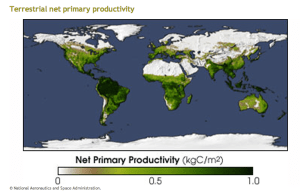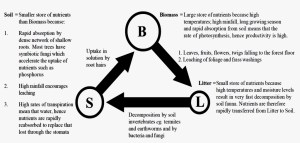Energy Flow and Nutrient Cycling in the TRF
Why do TRF ecosystems have high productivity? [Energy flow]
1. Large (Global) Scale: All tropical areas receive high levels of insolation. However, if forests generate their own cloud cover (through massive evapotranspiration) a large proportion of the incident radiation will be reflected at the atmospheric level and therefore total insolation may be less than in a non-forested area.
In the tropics the amount of incoming radiation exceeds that which is re-radiated as longwave radiation i.e. the tropics are a net absorber of solar energy. This ‘energy surplus’ gives rise to global wind circulation patterns and the Inter Tropical Convergence Zone (ITCZ).
The rainforest vegetation, which is classically described as being made up of 5 above-ground layers or strata is overall very efficient at absorbing incoming radiation.
See diagram below for the “fate” of incoming solar radiation (light) before it even reaches the earth’s surface. Only about 45 to 50% actually makes it to the surface, and even less reaches the green leaves of plants and forests.
2. Small (Local) Scale: From the proportion of light that manages to reach the Earth’s surface (less than 50%), only part of that light manages to penetrate the often closed canopy. It is usually absorbed by the smaller trees, epiphytes, climbers, tree ferns and giant herbs or saplings on the forest floor. Thus, incoming solar radiation is effectively converted to chemical energy in the process of photosynthesis.
In primary producers the main energy input is from the solar energy. In a plant, not all of the solar energy available actually makes it into the leaf. There is loss of energy by reflection from the leaf, transmission through the leaf, and because some of the energy is the incorrect wavelength.The energy that is taken up by the producer is then fixed by photosynthesis, although again a proportion of this energy is lost as it is used up during photosynthetic reactions. Of the energy that is fixed in photosynthesis some will be used during respiration whilst the remaining energy is the portion that is incorporated into the biomass. It is the energy that is incorporated into the biomass that is available for the next trophic level.
Of the 45-50% incoming solar radiation (light) that manages to reach the surface of the Earth through the atmosphere only a small proportion is actually absorbed by the green plants and forested areas. See image below…
Gross Primary Productivity (GPP) – the total amount of organic matter fixed during photosynthesis (kg/m2/year) is extremely high in the TRF. This is a direct consequence of the high temperatures, high rainfall, huge amounts of photosynthetically active material and extremely rapid rate of nutrient recycling. Plants, like every other organism, use some of the chemical energy fixed during photosynthesis for their own energy needs i.e. they respire. The remainder is known as Net Primary Productivity.
GPP is extremely high in TRF but R is also high because of the huge plant biomass which the photosynthesising tissues have to support. Despite this, NPP is still greater than in almost all other ecosystems on Earth ( algal beds and reefs are commonly greater).
Nutrient Cycling and Recycling in the Tropical Rainforest.
Evaluating two models. Is anything missing? What is similar? How are they different? What are the advantages and limitations of these models?








